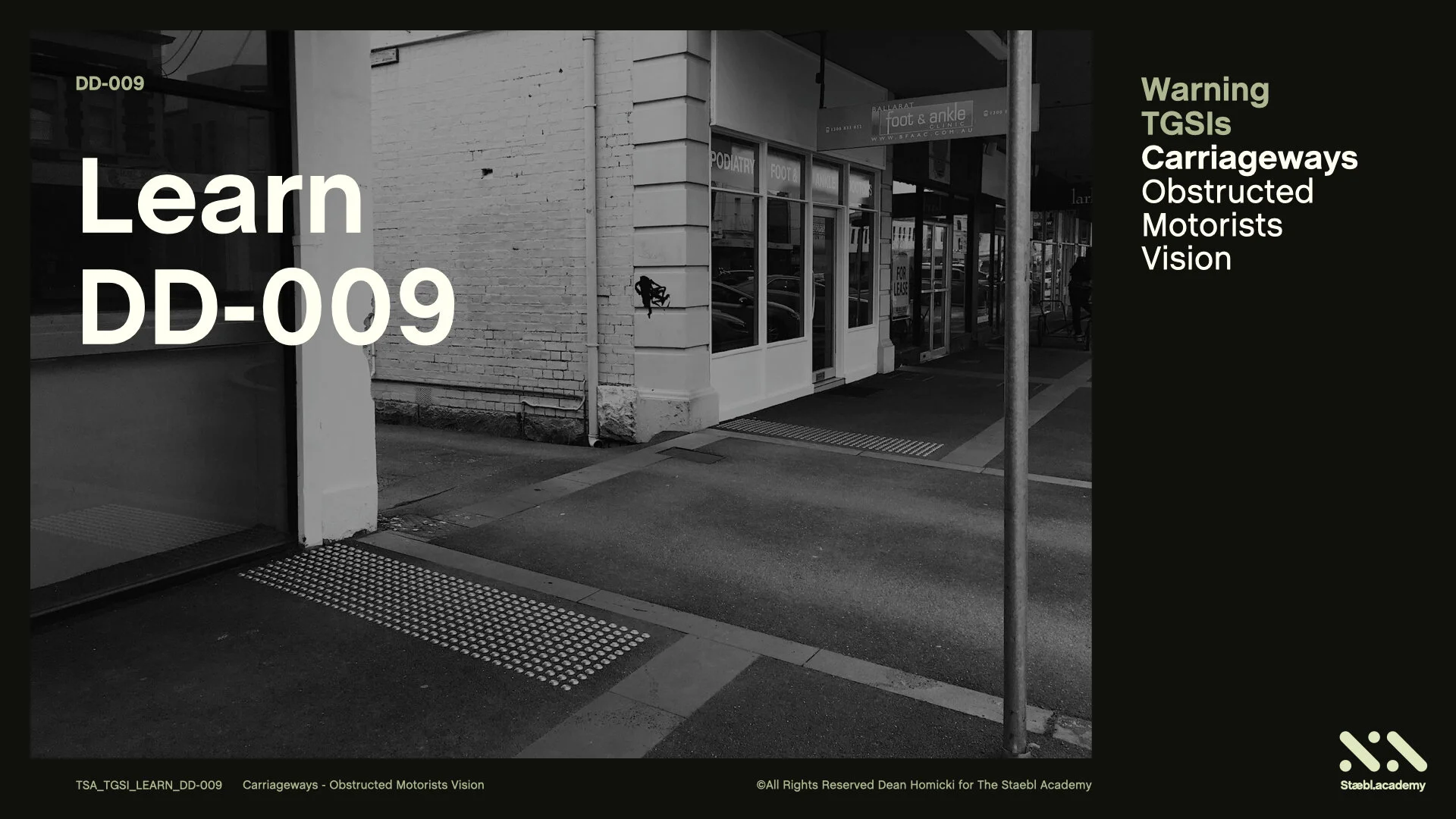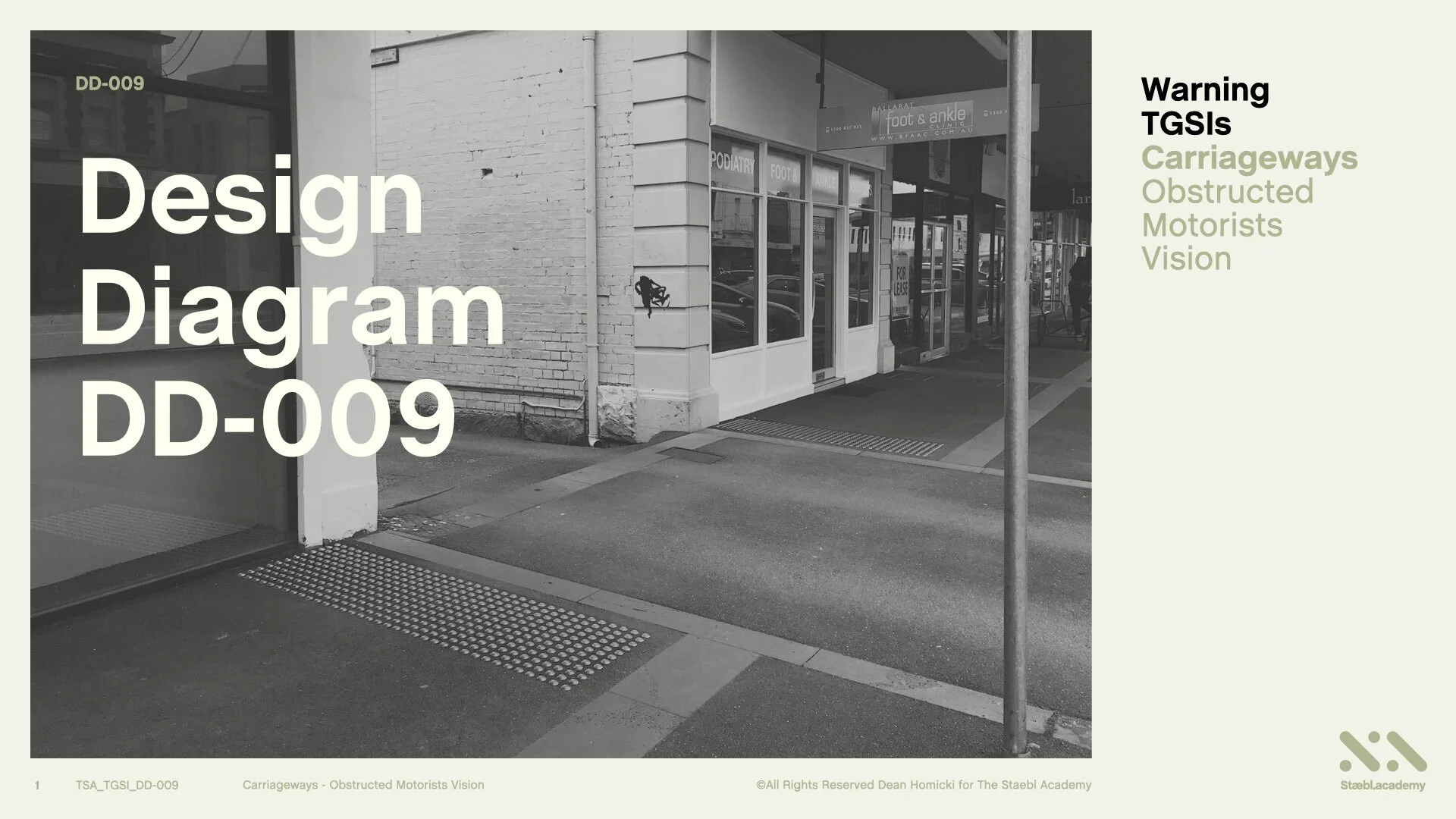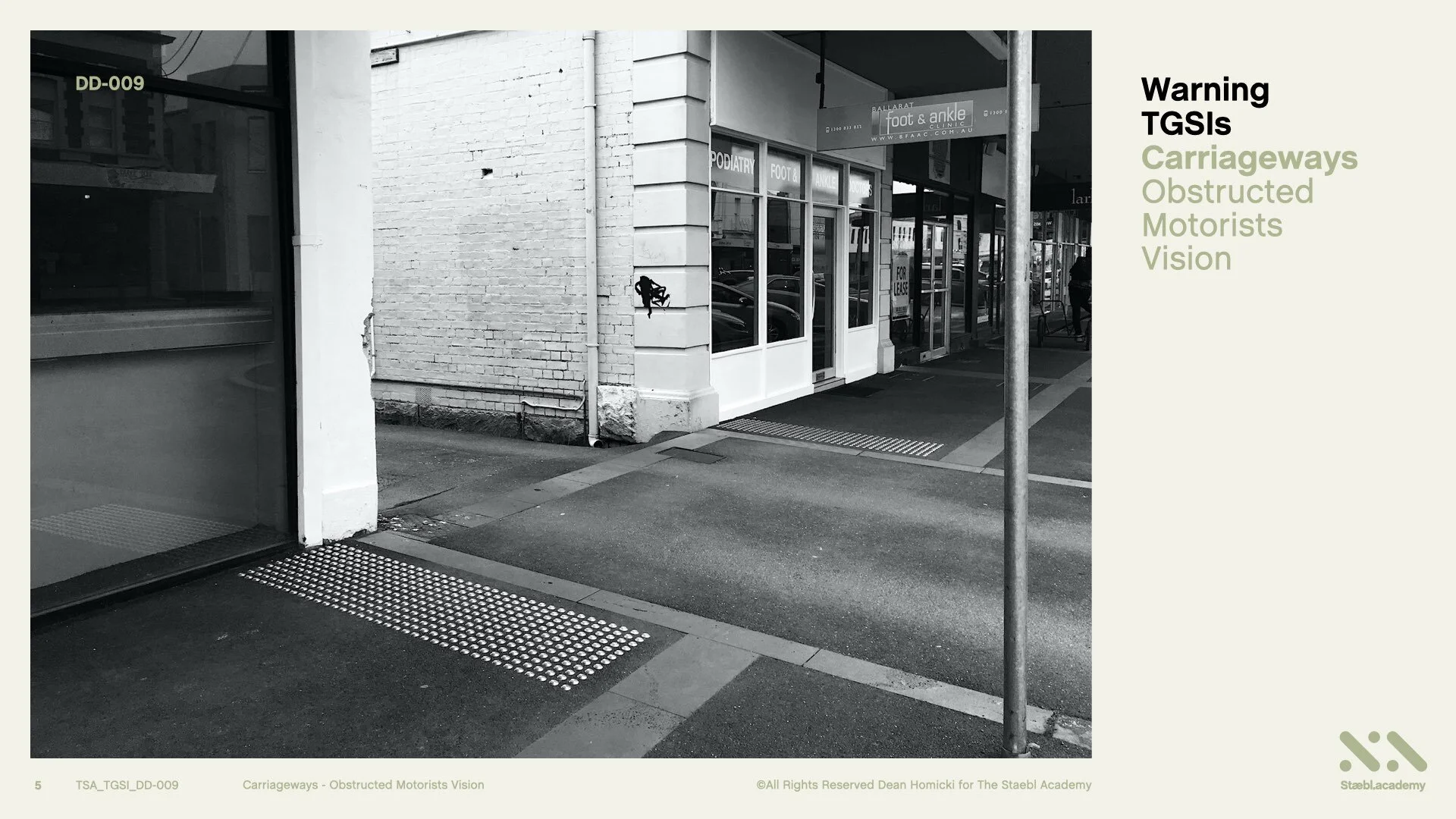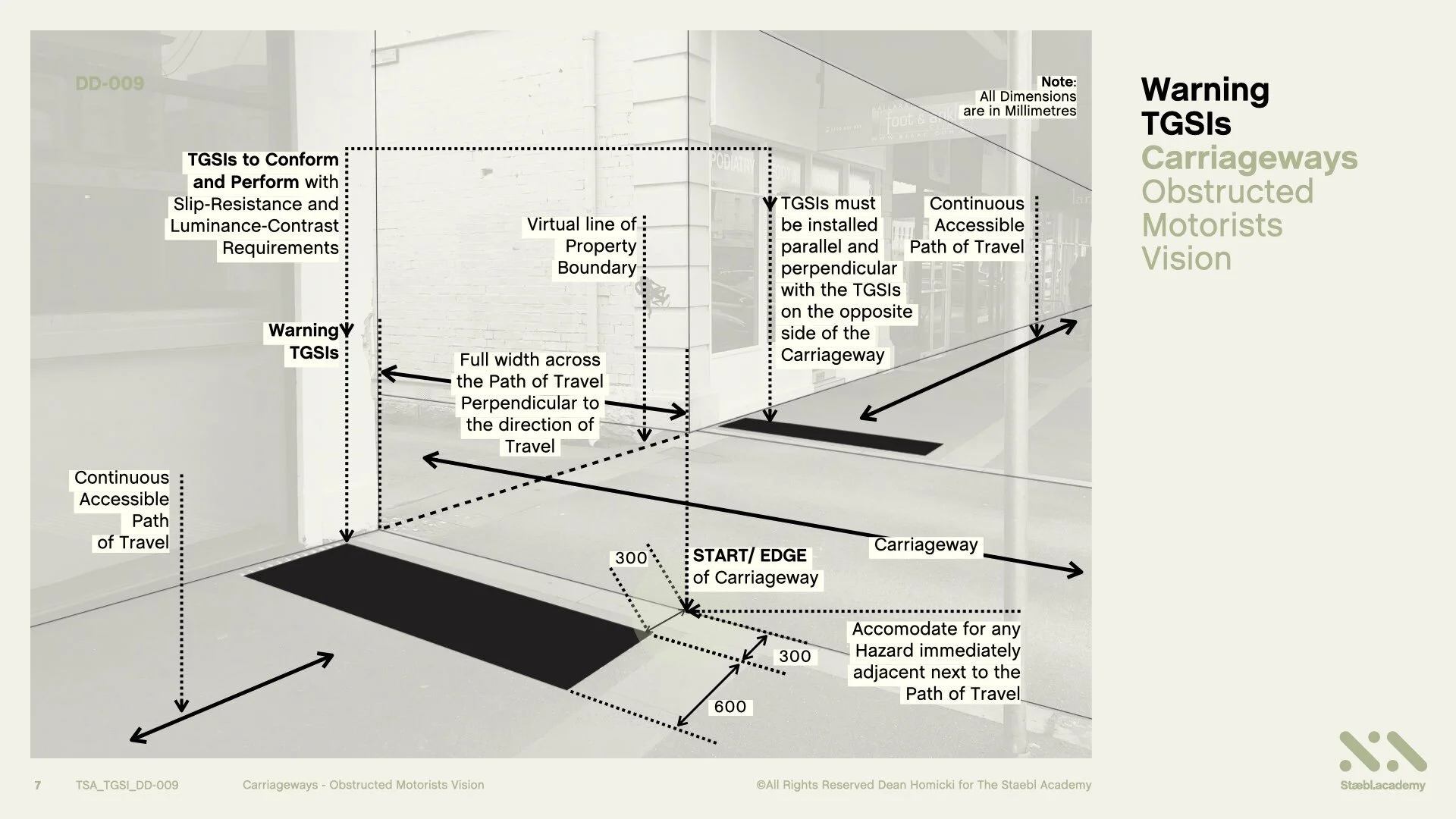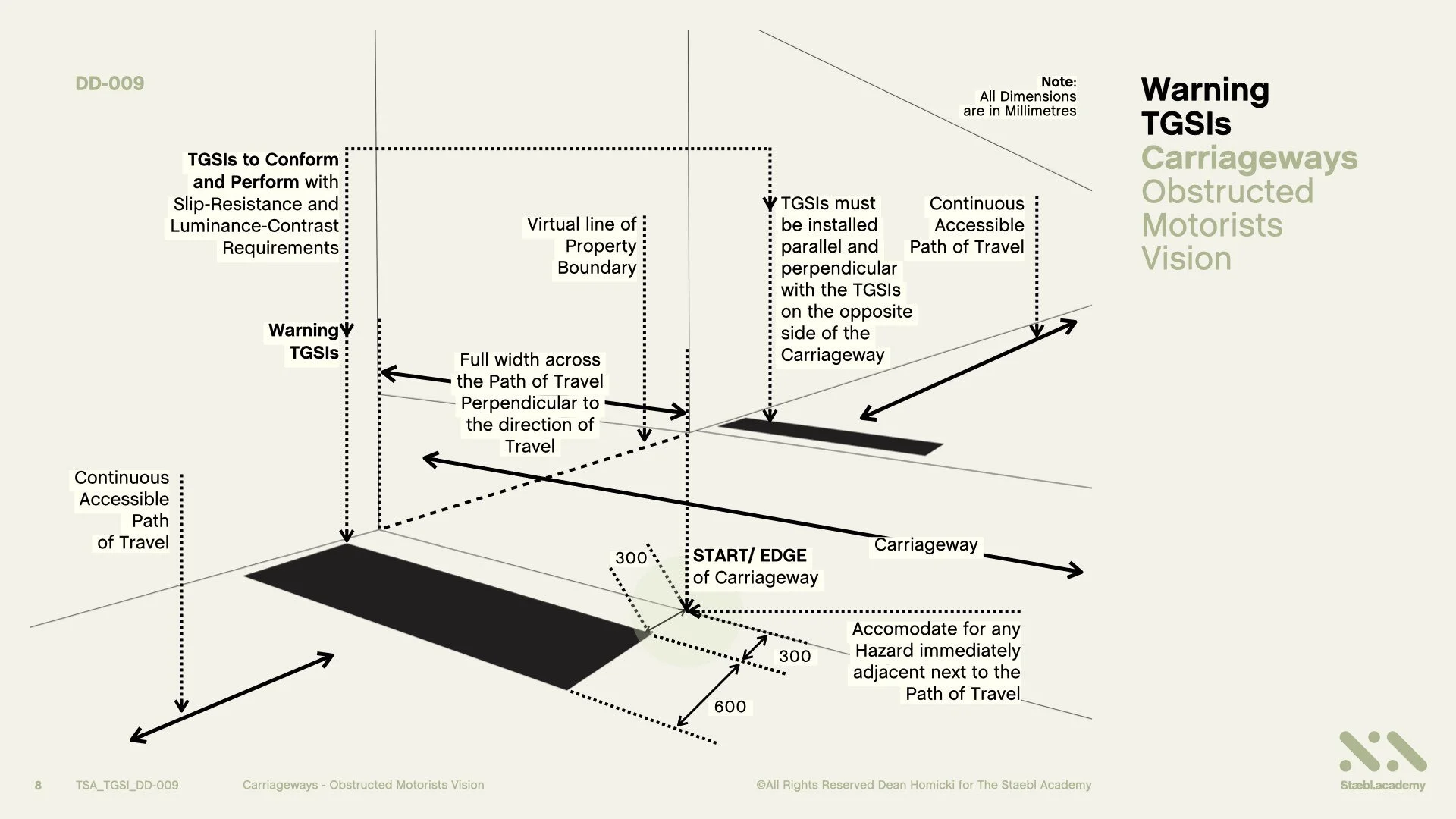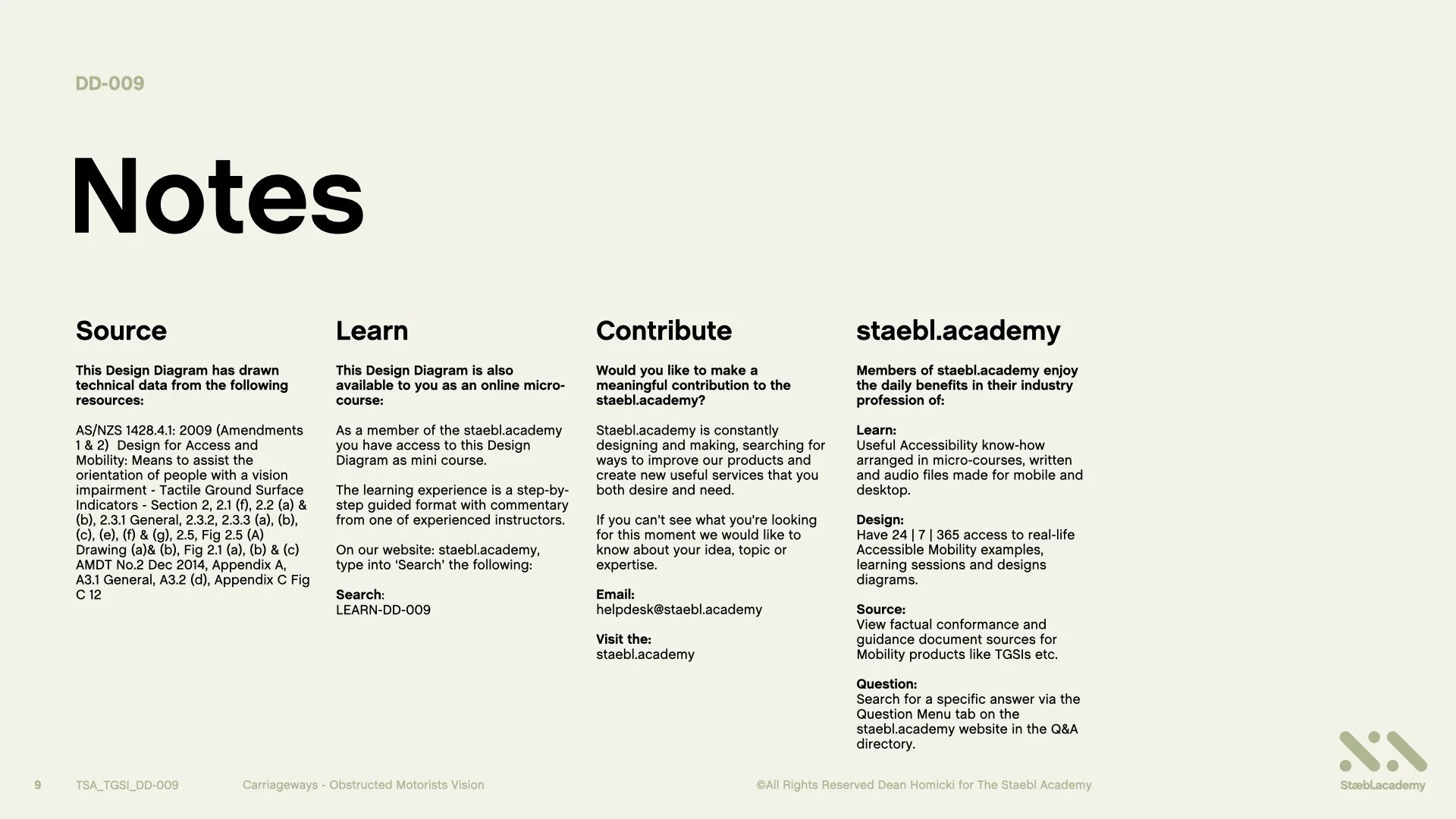Carriageways- Obstructed Motorists Vision
Course: DD-009 | Length: 6:41 mins | Instructor: Dean Homicki
Chapters
00:25 - Learning Overview
02:09 - Learning Session
02:39 - Let’s Begin
06:03 - Learning Resources
Transcript
This learning session will cover the use of Warning TGSIs on:
Carriageways, where and when a Motorists Vision is obstructed.
Welcome to staebl.academy TGSI Design Diagram 009. I’m Dean Homicki and I’ll be your guide for this course.
Learning Overview
Let’s review one type of Accessible Path of Travel, (ie a pedestrian footpath) that intersects with a vehicle Carriageway and Motorists’ or Pedestrian’s Vision is obstructed, and together extract what the Australian TGSI Standard requires of the situation.
Warning TGSIs Shall be set back 300 mm with a tolerance of +/- 10mm, from the start/edge of the Carriageway, or from the nearest point of the start of the incline, with or without a physical kerb, gutter or barrier, to a minimum depth of 600 mm, for the full width across the Path of Travel, and, must be perpendicular to the direction of travel.
TGSIs must be installed parallel and perpendicular with the TGSIs on the opposite side of Carriageway providing for persons who are blind or vision-impaired safe orientation and travel through the Pedestrian Crossing.
TGSIs for this application shall also conform and perform, with the applicable Slip Resistance and Luminance Contrast Requirements.
Here is a real-life situation of a Carriageway that’s crossing an Accessible Path of Travel, (the walkway), displaying how a Motorists’ vision is obstructed, with Discrete Warning TGSIs installed on the walkway to identify this hazard.
We are going to now convert this image it into a perspective line drawing and view how TGSIs have been used in this application.
Here’s the line drawing of the image.
Learning Session
How to use TGSIs in this situation?
In this example, both people and vehicles approach this pedestrian crossing without a clear view of each other. In other words, both the Pedestrian’s and Motorists vision is obstructed by the walls surrounding the carriageway.
For the orientation of persons who are blind or vision-impaired, applying this knowledge enables us to determine how to use TGSIs and conform to the specifications of the Australian TGSI standards.
Let’s Begin
On the top side of the Carriageway, we see an ‘Open Area’ - that is, an area that is accessible at and from multiple angles of approach to the hazard. The hazard is the carriageway that pedestrians will cross.
This scenario also applies to the opposite side of the Carriageway too, an ‘Open Area’ - that is, an area that is accessible at and from multiple angles of approach to the hazard.
We can view here the ‘Accessible Continuous Path of Travel’. This is the pedestrian walkway leading up to the Pedestrian Crossing. And, the Continuous Path of Travel on the lower side.
And here’s the Carriageway that intersects the Accessway or footpath.
Now, we can see the property boundary here.
Kerb Ramps or crossings that are aligned with Property Boundary, along the Accessible Path of Travel, provide enormous assistance for persons who are blind or vision-impaired.
An unobstructed Property Boundary or building-line can be used to shore-line and provide assistance to help orientate a person for safe movement and travel.
So, in this situation, TGSIs should always go to the property boundary. It’s okay to leave a gap of 50-100mm, (one human foot width), as there is no evidence to suggest that a person walks directly up against a property boundary or building line.
So, from the start or edge of the Carriageway or the beginning of the Kerb Ramp incline, we require Warning TGSIs to be set back from this edge 300 mm, with a tolerance of +/- 10mm.
If there is an adjacent Hazard immediately next to the Path of Travel, for example; the carriageway overlaps or it physically combines with the Kerb Ramp, (because the there is a sharp corner, a bollard or other potential hazard to a pedestrian, then the Warning TGSIs must set back 300 mm, with a tolerance of +/- 10mm from the start of the hazard.
This problem may occur when a Pedestrian Crossing intersects with a narrow, small or tight Carriageway corners. It may also happen with poorly designed kerb ramps or where the retrofitting of TGSI in existing infrastructure. TGSIs cannot fix bad design and caution should be applied when and if this design issue occurs.
So, to complete this design diagram, from the start or edge of the Carriageway or the beginning of the Kerb Ramp incline, Warning TGSIs must set back 300 mm, with a tolerance of +/- 10 mm from the start of the hazard, for a minimum depth of 600 mm. This equates to 12 TGSI nodes at 50 mm spacings. And, for the full width across the Accessible Path of Travel, and, must be perpendicular to the direction of travel.
This applies to the opposite side of the Pedestrian Crossing too. TGSIs must be installed parallel and perpendicular with the TGSIs on the opposite side of the Carriageway providing for persons who are blind or vision-impaired with safe orientation and travel.
TGSIs for this application, also need to conform and perform, with the applicable Slip-Resistance and Luminance-Contrast requirements.
And here is a real-life TGSI application once again.
Learning Resources
That’s the conclusion for Warning TGSIs on Carriageways, where and when a Motorists Vision is obstructed.
You can also access this course as a concise series of design diagrams in the resource section of our website staebl.academy/design. To access this resource now, click on the link below this video.
Thanks for joining me here at the staebl.academy. I look forward to guiding you through another learning session in the near future. Bye for now.
Listen
Click/Tap the audio player below to listen to the written transcript of this design session as an audible version. This is a streamed broadcast from the Staebl.academy site.
Diagrams
Click/Tap on an image from this learning session to view it as a larger picture. You will then be able to scroll through each individual design diagram in this slide-deck for a closer inspection.
Sources
TSA-TGSI-LEARN-DD-009 - This staebl.academy course module has drawn information from the following sources:
AS/NZS 1428.4.1: 2009 (Amendments 1 & 2) Design for Access and Mobility: Means to assist the orientation of people with a vision impairment - Tactile Ground Surface Indicators - Section 2, 2.1 (f), 2.2 (a) & (b), 2.3.1 General, 2.3.2, 2.3.3 (a), (b), (c), (e), (f) & (g), 2.5, Fig 2.5 (A) Drawing (a)& (b), Fig 2.1 (a), (b) & (c) AMDT No.2 Dec 2014, Appendix A, A3.1 General, A3.2 (d), Appendix C Fig C 12


